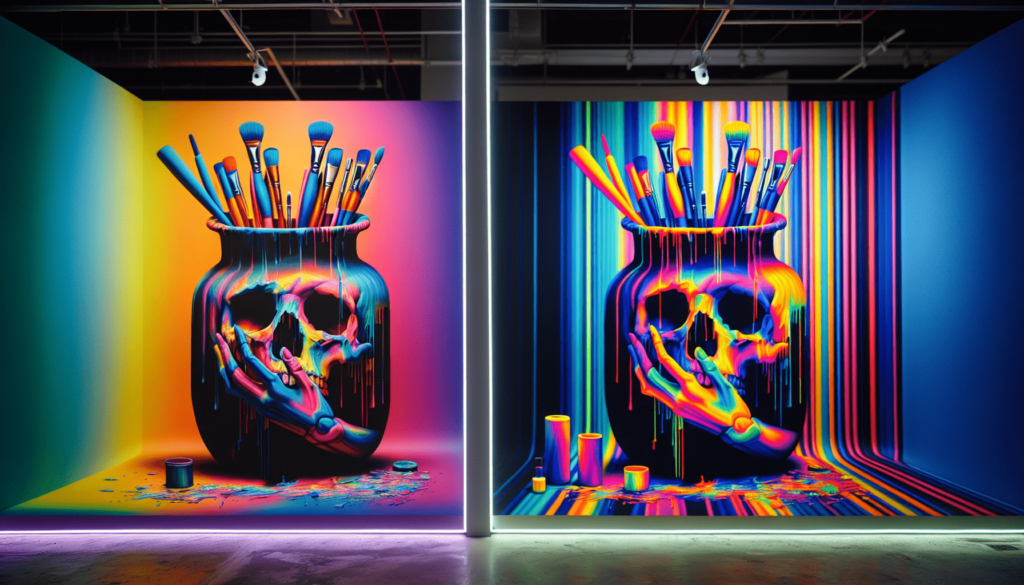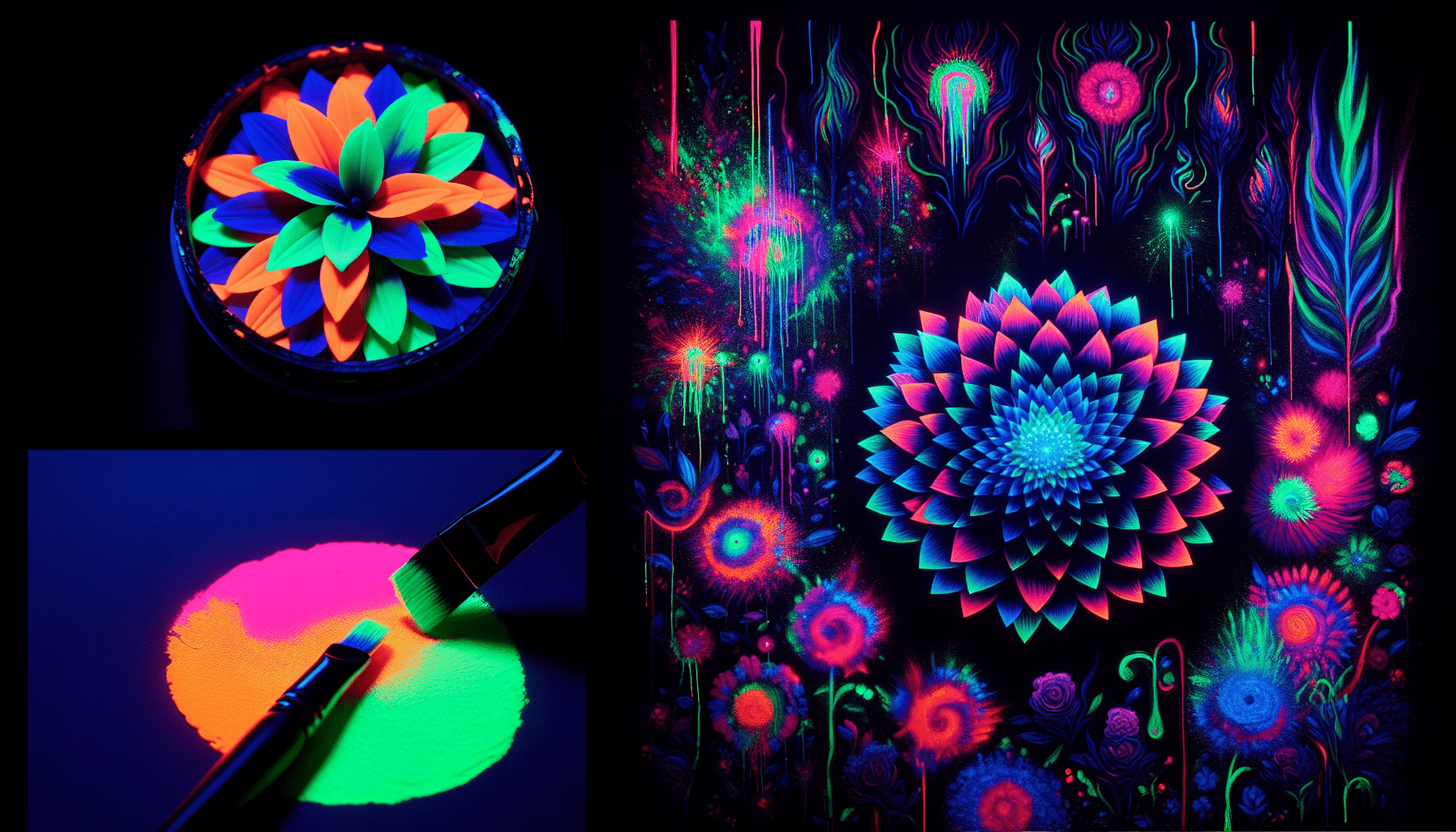Fluorescent paint, widely recognized for its vibrant and eye-catching properties, is often utilized in various industries to enhance visibility and create attention-grabbing designs. However, as you explore the realm of fluorescent paints, you may wonder: can this vivid and dazzling color eventually fade? In this article, we will examine the factors that contribute to the fading of fluorescent paint, offering insights into how this unique and captivating form of paint can withstand the test of time.
What is fluorescent paint?
Definition
Fluorescent paint is a type of paint that emits vibrant and intense colors when exposed to specific wavelengths of light. It contains pigments that have the ability to absorb energy from invisible ultraviolet (UV) light and re-emit it as visible light. This unique property creates a luminous and eye-catching effect, making fluorescent paint popular in various applications ranging from safety signage to art projects.
Composition
Fluorescent paint is typically made up of three main components: pigments, binders, and solvents. The pigments used in fluorescent paint are specially formulated to possess fluorescent properties. These pigments are derived from organic or inorganic compounds, and they undergo a process known as fluorescence when exposed to certain wavelengths of light. Binders, such as acrylic or epoxy resins, are added to hold the pigments together and ensure adhesion to the surface. Solvents help to maintain a workable consistency of the paint and aid in its application.
Factors affecting fluorescent paint fading
While fluorescent paint is known for its vibrant colors and long-lasting brightness, it is not completely immune to fading. Several factors can contribute to the fading of fluorescent paint over time. Understanding these factors is crucial in not only preserving the color intensity but also ensuring the longevity of the paint’s fluorescent properties.
Exposure to UV light
UV light is one of the primary factors that can cause fading of fluorescent paint. When fluorescent pigments are exposed to UV light, the high-energy rays can initiate chemical reactions within the pigments, leading to degradation and loss of color intensity. Prolonged exposure to UV light, especially in outdoor applications, can accelerate the fading process of fluorescent paint.
Temperature and humidity
Fluorescent paint can be affected by extreme temperature and humidity conditions. High temperatures can lead to the degradation of the paint’s binders, causing them to lose their adhesive properties and resulting in color fading. Similarly, moisture from high humidity levels can infiltrate the paint film, causing it to deteriorate over time and compromising its fluorescent properties.
Chemical exposure
Chemicals, such as solvents and cleaning agents, can have adverse effects on fluorescent paint. Some solvents may dissolve or soften the paint film, leading to color bleeding or fading. Similarly, certain cleaning agents may contain abrasive or harsh chemicals that can damage the paint’s surface, resulting in fading or discoloration.

Effects of UV light on fluorescent paint
UVA and UVB radiation
UV light can be categorized into UVA and UVB radiation. UVA radiation has a longer wavelength and is less intense than UVB radiation. However, it still has the potential to cause fading and degradation of fluorescent paint. UVB radiation, on the other hand, is more damaging and can lead to more significant color fading and deterioration of the paint film.
Photochemical reactions
When fluorescent paint is exposed to UV light, the energy absorbed by the pigments can initiate photochemical reactions. These reactions can cause changes in the molecular structure of the pigments, leading to chemical degradation and loss of color intensity. The extent of these reactions depends on the specific composition of the fluorescent pigments used in the paint as well as the duration and intensity of UV light exposure.
Impact of temperature and humidity on fluorescent paint
Heat-related degradation
High temperatures can accelerate the degradation of fluorescent paint by causing the binders to break down. As the binders lose their structural integrity, the fluorescent pigments can become dislodged from the surface, resulting in uneven color fading or complete loss of fluorescence. Additionally, prolonged exposure to high temperatures can cause the paint film to become brittle, making it more susceptible to cracking and chipping.
Moisture-induced fading
Excessive moisture, in the form of humidity or direct contact with water, can adversely affect fluorescent paint. Moisture can penetrate the paint film and cause it to soften or swell, leading to a breakdown of the binders and pigment displacement. As a result, the paint’s fluorescent properties can be compromised, and the colors may fade or become uneven.

Chemical exposure and its effects
Reaction with solvents and cleaning agents
Certain solvents, such as alcohol or acetone, can have a detrimental effect on fluorescent paint. These solvents can dissolve or soften the paint film, causing the pigments to bleed or become dislodged. Similarly, aggressive cleaning agents that contain harsh chemicals can damage the paint’s surface, resulting in fading or discoloration. It is important to use gentle cleaning products that are specifically formulated for use on fluorescent paint to minimize the risk of color fading.
Interaction with other materials
Fluorescent paint may come into contact with other materials, such as sealants or adhesives, in various applications. It is important to consider the compatibility of these materials with fluorescent paint to prevent any potential chemical reactions that could lead to fading or discoloration. Testing the compatibility of different materials beforehand can help ensure the longevity of the fluorescent paint’s vibrant colors.
Strategies to prevent fluorescent paint fading
Preserving the vibrant colors and fluorescent properties of paint can be achieved through various preventive measures. By incorporating these strategies, the risk of fading can be minimized, allowing fluorescent paint to maintain its visual impact for longer periods.
Protective coatings
Applying a clear protective coating over fluorescent paint can help shield it from UV light, temperature fluctuations, and environmental contaminants. These coatings act as a barrier, reducing the direct exposure of the paint to potentially damaging factors. Opt for coatings specifically designed for fluorescent paint to ensure compatibility and maintain the desired fluorescence.
Avoidance of harsh conditions
To prevent fading, it is important to limit the exposure of fluorescent paint to harsh conditions, such as direct sunlight or extreme temperatures. When using fluorescent paint outdoors, consider shading or covering the painted surfaces during peak sunlight hours to reduce UV light exposure. Similarly, avoid placing fluorescent-painted objects in areas prone to high humidity or extreme heat.
Proper storage and handling
Proper storage and handling of fluorescent paint can also contribute to its longevity. Store fluorescent paint in cool, dry areas away from direct sunlight. Ensure that containers are tightly sealed to prevent moisture infiltration. When handling fluorescent paint, use gentle brush strokes or a roller to avoid damaging the paint film and causing color fading.
Maintenance and care tips for fluorescent paint
To maintain the vibrancy of fluorescent paint, regular cleaning and proper handling are essential. Implementing the following care tips can help extend the lifespan of fluorescent paint and ensure its continued visual impact.
Regular cleaning
Regularly clean fluorescent-painted surfaces using mild soap and water. Avoid using abrasive materials or harsh cleaning agents that can damage the paint film. Gently pat-dry the surface after cleaning to prevent moisture buildup.
Avoidance of abrasive materials
When cleaning or handling fluorescent paint, avoid abrasive materials such as rough sponges or scrub brushes. These materials can scratch the paint surface and compromise its fluorescent properties. Use soft cloths or gentle cleaning tools to maintain the integrity of the paint film.
Proper handling
When touching or moving fluorescent-painted objects, handle them with care. Avoid applying excessive pressure or scratching the paint surface, as this can lead to color fading or damage. Wear gloves to prevent oils from transferring onto the paint surface, which can potentially affect its fluorescence.
Potential uses and applications of fluorescent paint
Fluorescent paint finds a wide range of applications due to its vibrant and attention-grabbing characteristics. Some common uses include:
Safety signage and markings
Fluorescent paint is commonly used for safety signage and markings, such as road signs, construction signs, and safety tape. The bright and intense colors enhance visibility, especially in low-light conditions, improving safety and the effectiveness of these signs.
Art and craft projects
Fluorescent paint adds a unique and vibrant touch to various art and craft projects. Whether it’s creating eye-catching paintings, decorating ceramics, or adding accents to fabric, the fluorescent properties of the paint create a striking visual impact.
Special effects in entertainment
The fluorescent properties of the paint make it a popular choice for special effects in the entertainment industry. From stage productions to theme parks, fluorescent paint is used to create glowing props, sets, and costumes that captivate audiences and add an element of magic to performances.
Testing and evaluation of fluorescent paint fade resistance
To assess the fade resistance of fluorescent paint and ensure its long-lasting qualities, various testing methods can be employed.
Accelerated weathering tests
Accelerated weathering tests simulate the effects of outdoor exposure on fluorescent paint by subjecting samples to controlled conditions of UV light, temperature, and humidity. These tests help evaluate the paint’s resistance to fading and degradation over an accelerated period of time.
Visual observation and comparison
Regular visual observation and comparison of fluorescent paint samples can provide valuable insights into their fade resistance. By regularly assessing the color intensity and brightness of painted surfaces, any signs of fading or discoloration can be detected early on, allowing for appropriate preventive measures to be taken.
Use of spectroscopy
Spectroscopy techniques can be used to analyze the optical properties of fluorescent paint. By measuring the reflectance and absorption spectra of the paint, the color intensity and fluorescence can be quantitatively assessed. This analysis can help determine the paint’s fading characteristics and aid in the development of more fade-resistant formulations.
Conclusion
Fluorescent paint, with its vibrant colors and striking fluorescent properties, adds a captivating element to various applications. While it is susceptible to fading over time, understanding the factors that contribute to fading and implementing preventive measures can help preserve the paint’s visual impact. By controlling exposure to UV light, managing temperature and humidity conditions, and practicing proper maintenance and care, the longevity of fluorescent paint can be extended. Additionally, testing and evaluation methods can provide valuable insights into the fade resistance of fluorescent paint, enabling the development of better formulations and ensuring continued brightness and vibrancy.



